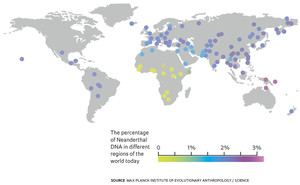 A recent study suggests that there may be more Neanderthal in modern Homo sapiens than previously thought. The study, coordinated by researchers at the Max Planck Institute for Evolutionary Anthropology in Leipzig, Germany, estimates that DNA from the Neanderthal—which went extinct between 30,000 and 40,000 years ago—represents 1.8%–2.6% of the DNA in modern humans of non-African origin (Science, October 5). People from Australia and Oceania have the most genetic material of Neanderthal origin, followed by Asians and Europeans (see map). Previous data has suggested that the DNA contribution of the Neanderthal, the most similar species to Homo sapiens, ranged from 1.5% to 2.1%. In Europe, the two species may have coexisted for thousands of years and may have interbred. The new comparison was based on the high-quality genome sequencing of a Neanderthal female that lived around 55,000 years ago. A bone fragment belonging to the Neanderthal woman was found in the Vindija cave, Croatia, from which it was possible to extract a DNA sample. The analyses also examined DNA sequences from other Neanderthals, the Denisova hominin (another extinct species), and modern humans from around the world. According to the study, there are clues in Neanderthal DNA that suggest they acquired genetic material from humans between 130,000 and 145,000 years ago. The study also found health-related genetic variations of Neanderthal origin in modern human populations, relating to cholesterol and vitamin D levels, eating disorders, visceral fat levels, rheumatoid arthritis, our response to psychotropic drugs, and even schizophrenia.
A recent study suggests that there may be more Neanderthal in modern Homo sapiens than previously thought. The study, coordinated by researchers at the Max Planck Institute for Evolutionary Anthropology in Leipzig, Germany, estimates that DNA from the Neanderthal—which went extinct between 30,000 and 40,000 years ago—represents 1.8%–2.6% of the DNA in modern humans of non-African origin (Science, October 5). People from Australia and Oceania have the most genetic material of Neanderthal origin, followed by Asians and Europeans (see map). Previous data has suggested that the DNA contribution of the Neanderthal, the most similar species to Homo sapiens, ranged from 1.5% to 2.1%. In Europe, the two species may have coexisted for thousands of years and may have interbred. The new comparison was based on the high-quality genome sequencing of a Neanderthal female that lived around 55,000 years ago. A bone fragment belonging to the Neanderthal woman was found in the Vindija cave, Croatia, from which it was possible to extract a DNA sample. The analyses also examined DNA sequences from other Neanderthals, the Denisova hominin (another extinct species), and modern humans from around the world. According to the study, there are clues in Neanderthal DNA that suggest they acquired genetic material from humans between 130,000 and 145,000 years ago. The study also found health-related genetic variations of Neanderthal origin in modern human populations, relating to cholesterol and vitamin D levels, eating disorders, visceral fat levels, rheumatoid arthritis, our response to psychotropic drugs, and even schizophrenia.

